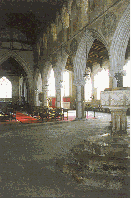 |
Home Architecture Furnishings The Organ Worship Welcoming Visitors Agnes Blencowe Conservation Work Nave Wall Paintings |
Stunning Architecture |
 The detached tower is much admired for its four stages of arches and rich ornamentation. The detached tower is much admired for its four stages of arches and rich ornamentation. |
Tower: |
The south porch  |
Entrances:
Nave arcade: |
 Superb 13th century arcading said by Betjeman to be one of the best in England. Superb 13th century arcading said by Betjeman to be one of the best in England. |
|
South window:
Wall paintings: |
 |